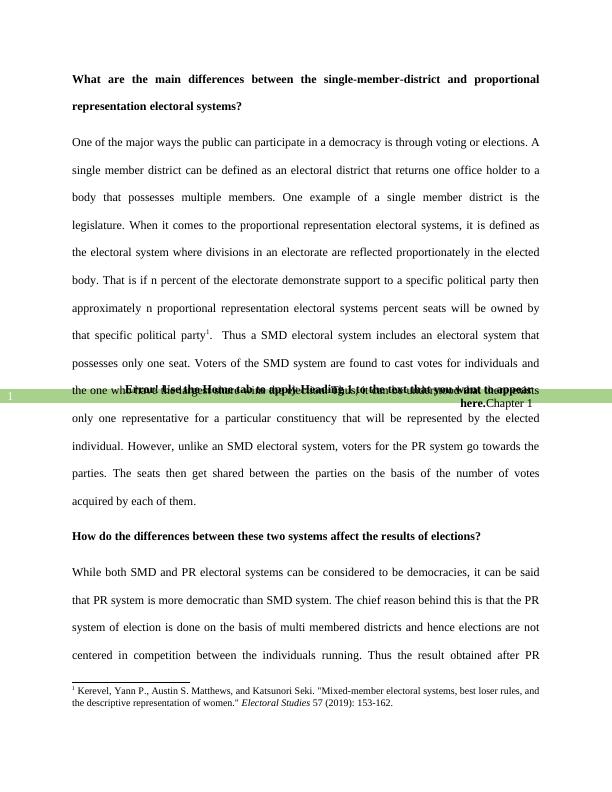Single Member District Electoral System
Added on 2022-08-18
6 Pages985 Words36 Views
Running head:
Name of the Student
Name of the University
Author Note
Name of the Student
Name of the University
Author Note

Error! Use the Home tab to apply Heading 1 to the text that you want to appear
here.Chapter 1
1
What are the main differences between the single-member-district and proportional
representation electoral systems?
One of the major ways the public can participate in a democracy is through voting or elections. A
single member district can be defined as an electoral district that returns one office holder to a
body that possesses multiple members. One example of a single member district is the
legislature. When it comes to the proportional representation electoral systems, it is defined as
the electoral system where divisions in an electorate are reflected proportionately in the elected
body. That is if n percent of the electorate demonstrate support to a specific political party then
approximately n proportional representation electoral systems percent seats will be owned by
that specific political party1. Thus a SMD electoral system includes an electoral system that
possesses only one seat. Voters of the SMD system are found to cast votes for individuals and
the one who have the largest share wins the election. Thus, it can be understood that there exists
only one representative for a particular constituency that will be represented by the elected
individual. However, unlike an SMD electoral system, voters for the PR system go towards the
parties. The seats then get shared between the parties on the basis of the number of votes
acquired by each of them.
How do the differences between these two systems affect the results of elections?
While both SMD and PR electoral systems can be considered to be democracies, it can be said
that PR system is more democratic than SMD system. The chief reason behind this is that the PR
system of election is done on the basis of multi membered districts and hence elections are not
centered in competition between the individuals running. Thus the result obtained after PR
1 Kerevel, Yann P., Austin S. Matthews, and Katsunori Seki. "Mixed-member electoral systems, best loser rules, and
the descriptive representation of women." Electoral Studies 57 (2019): 153-162.
here.Chapter 1
1
What are the main differences between the single-member-district and proportional
representation electoral systems?
One of the major ways the public can participate in a democracy is through voting or elections. A
single member district can be defined as an electoral district that returns one office holder to a
body that possesses multiple members. One example of a single member district is the
legislature. When it comes to the proportional representation electoral systems, it is defined as
the electoral system where divisions in an electorate are reflected proportionately in the elected
body. That is if n percent of the electorate demonstrate support to a specific political party then
approximately n proportional representation electoral systems percent seats will be owned by
that specific political party1. Thus a SMD electoral system includes an electoral system that
possesses only one seat. Voters of the SMD system are found to cast votes for individuals and
the one who have the largest share wins the election. Thus, it can be understood that there exists
only one representative for a particular constituency that will be represented by the elected
individual. However, unlike an SMD electoral system, voters for the PR system go towards the
parties. The seats then get shared between the parties on the basis of the number of votes
acquired by each of them.
How do the differences between these two systems affect the results of elections?
While both SMD and PR electoral systems can be considered to be democracies, it can be said
that PR system is more democratic than SMD system. The chief reason behind this is that the PR
system of election is done on the basis of multi membered districts and hence elections are not
centered in competition between the individuals running. Thus the result obtained after PR
1 Kerevel, Yann P., Austin S. Matthews, and Katsunori Seki. "Mixed-member electoral systems, best loser rules, and
the descriptive representation of women." Electoral Studies 57 (2019): 153-162.

Error! Use the Home tab to apply Heading 1 to the text that you want to appear
here.Chapter 1
2
election allows small parties to acquire seat in the legislature while the SMD system does not.
Thus the SMD system allows fewer and larger parties to win seat in the legislature whereas the
PR system allows smaller parties as well to do the same2.
What are the advantages and disadvantages of each system?
Advantages Disadvantages
Single member district Provides the voters
with the strong
constituency
representation size
each of the voters
possess a single, easily
identifiable direct
representative
Enhance the
accountability since a
single representation
can be held
responsible, reelected
as well as defeated in
the next election
Ensures geographical
Needs to redraw in a
regular basis do that
the population of the
relatively equal size
can be maintained.
Includes artificial
geographical entities
who boundaries are
clearly not identifiable
Due to their tendency
to over represent the
major arty, this system
tends to underrepresent
minor parties.
2 Rule, W., 2019. Political Rights, Electoral Systems, and the Legislative Representation. Handbook of Global
Social Policy, p.73.
here.Chapter 1
2
election allows small parties to acquire seat in the legislature while the SMD system does not.
Thus the SMD system allows fewer and larger parties to win seat in the legislature whereas the
PR system allows smaller parties as well to do the same2.
What are the advantages and disadvantages of each system?
Advantages Disadvantages
Single member district Provides the voters
with the strong
constituency
representation size
each of the voters
possess a single, easily
identifiable direct
representative
Enhance the
accountability since a
single representation
can be held
responsible, reelected
as well as defeated in
the next election
Ensures geographical
Needs to redraw in a
regular basis do that
the population of the
relatively equal size
can be maintained.
Includes artificial
geographical entities
who boundaries are
clearly not identifiable
Due to their tendency
to over represent the
major arty, this system
tends to underrepresent
minor parties.
2 Rule, W., 2019. Political Rights, Electoral Systems, and the Legislative Representation. Handbook of Global
Social Policy, p.73.

End of preview
Want to access all the pages? Upload your documents or become a member.
Related Documents
Democratic parliamentary system of United Kingdomlg...
|9
|2002
|35
Party system of australia and its efficiencylg...
|12
|3813
|18
Basic Concepts of Democracylg...
|10
|2822
|158
Voting System: Pros, Cons, and the Need for Changelg...
|12
|655
|65
PSCI 100: Introduction to Political Sciencelg...
|8
|1897
|33
Australian Politics Assignment PDFlg...
|4
|674
|77
